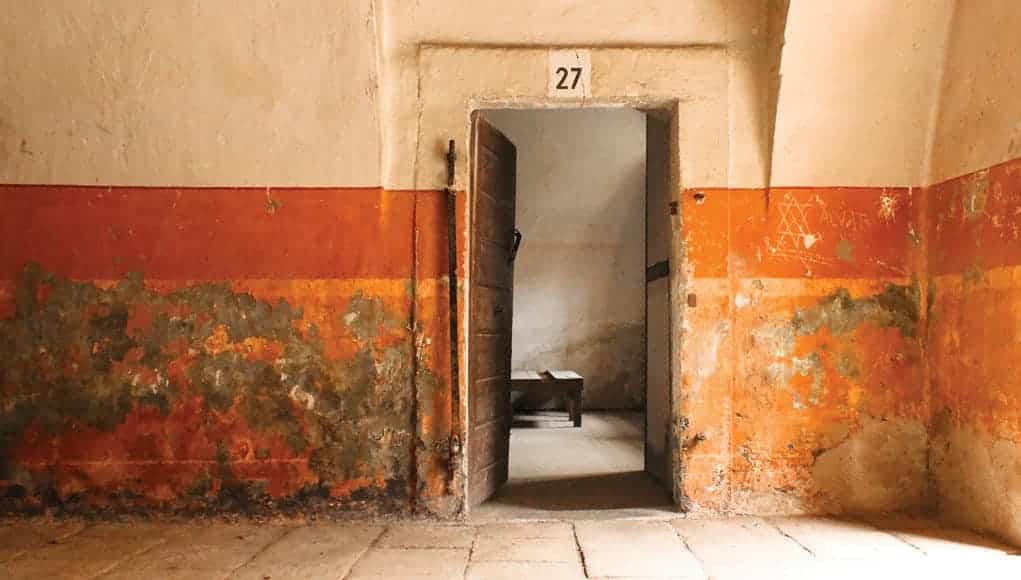by Rebecca M. Alvin
It’s hard to think of an uglier subject than the mass extermination of human beings that occurred in the Holocaust. Millions of people rounded up, tortured, stripped of their dignity, and often murdered in the official systematic process to fulfill Hitler’s “Final Solution.” But once it was over, and the concentration camps were liberated in 1945, what became of the buildings, the sites of such horrors? In Alain Resnais’ 1955 documentary Night and Fog, harsh images of life at the camps (footage mostly shot by the Nazis themselves, who were chronic documenters of their own atrocities) is interspersed with then-present-day footage of the silent structures, empty, powerless, and yet imbued with meaning, evidence, and traumatic memories.
All these decades later, many concentration camps still stand as historic sites that visitors come to so they can bear witness to what happened at such places. When photographer Curtis Speer was given the opportunity to go to Prague in 2011, he wanted to visit one particular concentration camp that had a very specific place in the Nazi system: Theresienstadt.
“Theresienstadt was one of the camps that I’ve always kind of been fascinated by… being that I’m a gay guy and a creative guy, because Hitler used this camp as a labor camp, but it was full of creative people,” explains Speer. Although he shot the photographs eight years ago, he is exhibiting them now here in Provincetown at his Cusp Gallery for the month of October.

Speer went to the camp on his own and walked the grounds photographing both the interior and exterior using naturally occurring light so as not to “create a production out of my presence there. I wanted to respect the grounds,” as he recalls.
The images Speer created document the architecture of a place of horrors. Originally built in the 1600s as a fort to keep invaders out, Theresienstadt was repurposed by the Nazis in 1941 when Jewish laborers were brought in to prepare it for the prisoners who would come through either as a stop before being sent to Auschwitz or another extermination camp, or because they were considered high-profile and the Nazis didn’t want too many questions asked about their whereabouts. It was also kind of a show camp, one that could be used when, for example, the Red Cross wanted to visit a camp. And due to the deliberate concentration of culturally accomplished inhabitants there, it was also a place where prisoners were able to experience cultural activities other camps did not foster. This was all part of the Nazi propaganda machine, a set up to prove the camps were not so bad, even having a kind of school there for the children.
Speer’s interiors show spaces now empty but which once housed thousands of Holocaust victimes. And yet there is a certain beauty to the quiet of the cracked paint, rusted door bolts no longer locking anyone in, and the play of sunlight on the harsh wooden benches and beds where so many undoubtedly once lay in terror awaiting their fate. In two companion shots called 27 and 28, hung in the first floor of the gallery, Speer shows an open doorway surrounded by orange and cream colored walls with a red stripe through the middle. In 27 the Star of David is carved into the stripe with the word Alvar (perhaps someone’s last name) carved next to it. Scratched and crumbling, discolored and damaged, the image shows a once horrific place that has been rendered harmless and sad from the perspective of today’s eyes, nearly 75 years after the camp was liberated.

What stood out to Speer looking at these rooms was “the volume of people that passed through there… A lot of those rooms—and they’re pretty tiny bunkers—they would cram hundreds of people in those. So I photographed each room standing against the opposite wall of the window, just to kind of give you an idea that the rooms aren’t very big. This wasn’t an extermination camp, but thousands and thousands of people passed away there because of sickness.” In fact, it’s estimated that 33,000 people died there and another 88,000 who were there were eventually sent to extermination camps where most of them perished. Of those people, 15,000 were children.
The exterior shots show a once mighty fort being overtaken by the natural environment that is steadily reclaiming the buildings, perhaps for the best. Speer was most impressed with the architecture and really wanted to capture that in these images.
While these were taken some time ago and many have since been added to the permanent collection of the U.S. Holocaust Memorial Museum in Washington, D.C., their power still resonates and Speer recalls vividly what it felt like to be there taking these photographs. “Without getting too woo-woo— you pick up on the energy of the space,” says Speer. “My heart sunk, but then it was like wow this is really beautiful. Of course, you know, I’m teary eyed the whole time… And it holds true. If I were to go back there, I’d probably go through the same gamut of emotions,” he adds.
Curtis Speer’s photographs of Theresienstadt are on exhibition in a show called Inside These Walls at Cusp Gallery, 115 Bradford St., Provincetown, through October 25. For more information call 323. 513.3161 or visit cuspgallery.com.











